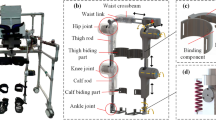Abstract
A critical issue in the control of exoskeleton systems is unknown nonlinear dynamic properties of the system. The improper estimation of those unknown properties can cause considerable human-exoskeleton interaction force during human’s movements. It is really challenging to exactly estimate the parameters of dynamic models. In this paper, we propose a novel exoskeleton control algorithm to both compensate for the dynamic uncertainty error and minimize the human-exoskeleton interaction force. We have built a virtual torque controller based on dynamic models of a lower exoskeleton and have used an approximation of a Radial Basis Function (RBF) neural network to compensate for the dynamic uncertainty error. By doing so, we avoid using complicated force sensors installed on the human-exoskeleton interface and minimize the physical Human-Robot Interaction (pHRI) force. Moreover, we introduce the prototype of our exoskeleton system, called ‘PRMI’ exoskeleton system. Finally, we validated the proposed algorithm on this system, and the experimental results show that the proposed control algorithm provides a good control quality for the ‘PRMI’ exoskeleton system by compensating for dynamic uncertainty error.
Similar content being viewed by others
References
Anam, K., Al-Jumaily, A.A.: Active exoskeleton control systems: state of the art. In: International symposium on robotics and intelligent sensors (IRIS 2012), p 988994 (2012)
Kundu, A.S, Mazumder, O., Chattaraj, R., Bhaumik, S.: Trajectory generation for myoelectrically controlled lower limb active knee exoskeleton. In: Seventh international conference on contemporary computing (IC3), pp 230–235 (2014)
Lu, R., Li, Z., Su, C.-Y., Xue, A.: Development and learning control of a human limb with a rehabilitation exoskeleton. IEEE Trans. Ind. Electron. 6(7), 3776–3785 (2014)
Lee, J., Kim, H., Jang, J., Park, S.: A simulation study on the control of lower extremity exoskeleton for assistance of human locomotion, 44th international symposium on robotics (isr). In: 44th international symposium on robotics (ISR), pp 1–4 (2013)
Onen, U., Botsali, F.M., Kalyoncu, M., Tinkir, M., Yilmaz, N., Sahin, Y.: Design and actuator selection of a lower extremity exoskeleton. IEEE/ASME Trans. Mechatron. 19(2), 623–632 (2014)
Veneman, J.F., Van der Kooij, H, al, el: Can isps and p2p users cooperate for improved performance IEEE Trans. Neural Syst. Rehabil. Eng. 15(3), 379–386 (2007)
Christine, A.C., Herman, V.K.: Assistive and rehabilitation robotics. J. Behav. Robot. 2(4), 175–175 (2011)
Erol, D., Sarkar, N.: Intelligent control for robotic rehabilitation after stroke. J. Intell. Robot. Syst. 50(4), 341–360 (2007)
Kazerooni, H.: Human augmentation and exoskeleton systems in berkeley. Int. J. Humanoid Robotics 4(3), 575–605 (2007)
Walsh, C.J., Endo, K., Herr, H.: Aquasi-passive leg exoskeleton for load-carrying augmentation. Int. J. Humanoid Robotics 4(3), 487–506 (2007)
Low, K.H., Liu, X., Haoyong, Y.: Development of ntu wearable exoskeleton system for assistive technologies. In: IEEE International Conference on Mechatronics and Automation, pp 1099–1106 (2005)
Low, K.H., Liu, X., Haoyong, Y.: Design and implementation of ntu wearable exoskeleton as an enhancement and assistive device. In: IEEE international conference on mechatronics and automation, pp 209–225 (2005)
Yang, Z., Zhu, Y., Yang, X., Zhang, Y.s: Impedance control of exoskeleton suit based on adaptive rbf neural network. In: International conference on intelligent human-machine systems and cybernetics, pp 182–187 (2009)
Hyon, S.-H., Hayashi, T., Yagi, A., Noda, T., Morimoto, J.: Design of hybrid drive exoskeleton robot xor2. In: IEEE/RSJ International Conference on Intelligent Robots and Systems (IROS), pp 4642–4648 (2013)
Kazerooni, H.: Exoskeletons for human power augmentation. In: IEEE/RSJ international conference on intelligent robots and systems(IROS 2005), pp 3459–3464 (2005)
Kazerooni, H., Chu, A., Steger, R.: That which does not stabilize, will only make us stronger. Int. J. Robot. Res. 26(1), 75–89 (2007)
Kazerooni, J.L., Racine, H., Huang, L., Steger, R.: On the control of the berkeley lower extremity exoskeleton (bleex). In: Proceedings of the 2005 IEEE international conference on robotics and automation, (ICRA), pp 4353–4360 (2005)
Kazerooni, H., Huang, L., Steger, R.: Hybrid control of the berkeley lower extremity exoskeleton (bleex). Int. J. Robot. Res. 25(5–6), 561–573 (2006)
Yang, Z., Gui, L., Yang, X., Wenjin, G.: Simulation research of exoskeleton suit based on neural network sensitivity amplification control. In: Chinese control and decision conference, (CCDC 2008), pp 3340–3344 (2008)
Sankai, Y.: Hal: Hybrid assistive limb based on cybernics. Springer Tracts in Advanced Robotics 66, 25–34 (2011)
Wang, S.W., Yu, D.W., Yu, D.L.: Compensation for unmatched uncertainty with adaptive rbf network. Int. J. Eng. Sci. Technol. 3(6), 18–34 (2011)
Schilling, R.J., Carroll, J.J., Al-Ajlouni, A.F.: Approximation of nonlinear systems with radial basis function neural networks. IEEE Trans. Neural Netw. 12(1), 1–15 (2001)
DAmico, A., Ippoliti, G., Longhi, S.: A multiple models approach for adaptation and learning in mobile robots control. J. Intell. Robot. Syst. 47(1), 3–31 (2006)
Anderson, R.T., Chowdhary, G., Johnson, Eric N.: Comparison of rbf and shl neural network based adaptive control. J. Intell. Robot. Syst. 54(1–3), 183–199 (2009)
Prabhu, S.M., Devendra, P.G.: Artificial neural network based robot control: an overview. J. Intell. Robot. Syst. 15(4), 333–365 (1996)
Ni, J., Song, Q.: Pruning based robust backpropagation training algorithm for rbf network tracking controller. J. Intell. Robot. Syst. 48, 375–396 (2007)
Khalil, H.K.: Chapter 4: lyapunov stability, nonlinear system, 3rd edn. Prentice Hall (2002)
Author information
Authors and Affiliations
Corresponding author
Rights and permissions
About this article
Cite this article
Duong, M.K., Cheng, H., Tran, H.T. et al. Minimizing Human-Exoskeleton Interaction Force Using Compensation for Dynamic Uncertainty Error with Adaptive RBF Network. J Intell Robot Syst 82, 413–433 (2016). https://doi.org/10.1007/s10846-015-0251-x
Received:
Accepted:
Published:
Issue Date:
DOI: https://doi.org/10.1007/s10846-015-0251-x




